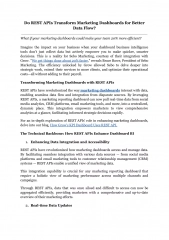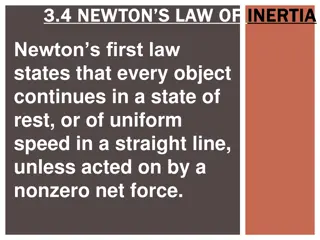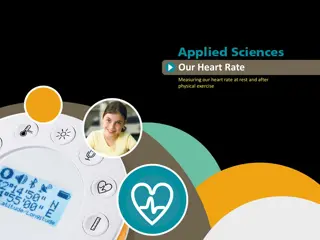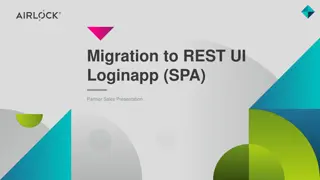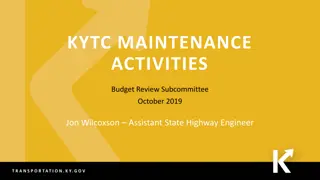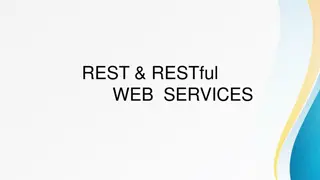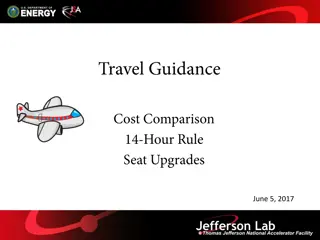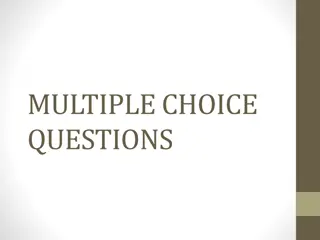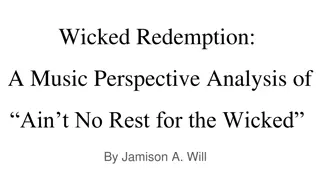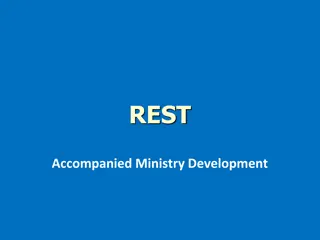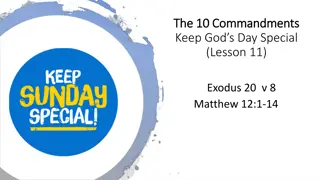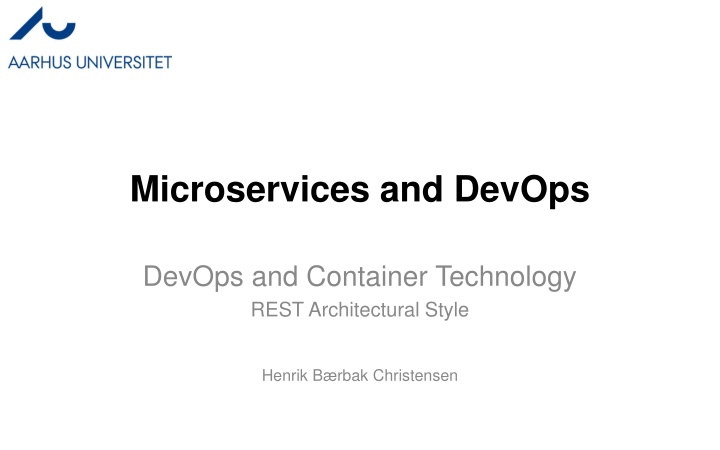
REST Architectural Style and HTTP Basics
Explore the fundamental concepts of REST architectural style, including its role as an architectural pattern, client-server model, and the basics of HTTP protocol. Learn about the evolution of web technologies and the key components that define modern web interactions.
Download Presentation

Please find below an Image/Link to download the presentation.
The content on the website is provided AS IS for your information and personal use only. It may not be sold, licensed, or shared on other websites without obtaining consent from the author. If you encounter any issues during the download, it is possible that the publisher has removed the file from their server.
You are allowed to download the files provided on this website for personal or commercial use, subject to the condition that they are used lawfully. All files are the property of their respective owners.
The content on the website is provided AS IS for your information and personal use only. It may not be sold, licensed, or shared on other websites without obtaining consent from the author.
E N D
Presentation Transcript
Microservices and DevOps DevOps and Container Technology REST Architectural Style Henrik B rbak Christensen
REST: The Fast Version Assuming you already know REST
Architectural Style As a software architect, I see REST as an Architectural style / pattern It is a specific programming model Functional programming: Computation is passing data through chains of functions Object programming: Computation is community of objects passing messages RPC over Client-Server: Computation is clients invoking procedures on remote servers REST Computation is clients manipulating resources using CRUD ops and moving through states using hypermedia links CS@AU Henrik B rbak Christensen 3
The Basics: Client-Server Well defined roles of components and connectors Reactive Server Active Client Client Client Client Client Ala: web browsing, facebook, CS@AU Henrik B rbak Christensen 4
The Basic: WWW Tim Berners-Lee approx. 1989 - 1990 Task: Sharing research documents at CERN model Solution: Hypertext protocol over TCP/IP for retrieving documents pplication ransport nternet Actually very simple text based format in t ernet protocol CS@AU Henrik B rbak Christensen 5
The Basis: HTTP HTTP = Hyper Text Transfer Protocol Application Protocol for Distributed Information Systems Exchanging information between clients and server Has four parts Verbs: GET, POST, PUT, DELETE Corresponds to normal database CRUD operations Standardized data formats Media types: text/html, image/gif, application/json Message format in text Verb + Headers (key/value) + empty line + body Standard Error Code Vocabulary 200 K, 404 N F N , 201 R , CS@AU Henrik B rbak Christensen 6
Message Format Request line Verb Header key-values Text format ! resource HTTP version Reply line Status line HTTP codes Header fields Message body CS@AU Henrik B rbak Christensen 7
Roy Fieldings work Goal: Keep the scalable hypermedia properties of WWW REST = REpresentational State Transfer Transferring a representation of data in a format matching one of standard data types (media types) Resource: any information that can be named Identified by a resource identifier URI = Uniform Resource Identifier Interactions are stateless Each request contains all the information necessary Exercise: Why is everybody so keen on stateless ? What QA is involved? CS@AU Henrik B rbak Christensen 8
Resource Identifier: URI URI: Uniform Resource Identifier URL = URI in which resource location and means are defined http://www.baerbak.com/contact.html Exercise: http://localhost:4567/bin Identify the parts of the URI CS@AU Henrik B rbak Christensen 9
CRUD by REST I can now design an Information System using the REST style. xample a clipboard web server POST on /pastebin/ with a message body = CREATE a new clip (resource) on the clipboard, assign resource ID GET on /pastebin/100 = READ the stored clip in the provided resource ID PUT on /pastebin/100 with a complete new message body = UPDATE the contents of the resource DELETE on /pastebin/100 = you get it CS@AU Henrik B rbak Christensen 10
Demo S Fis and Hest in bins Assigned bin 100, 101 GET bin 101 W ic is Hest GET bin 117 Which is not found (404) CS@AU Henrik B rbak Christensen 11
HATEOAS One drawback of REST compared to other programming models In oo/procedural/functional you can define methods that do complex algoritms over multiple objects resources Not just: create, read, update, delete Solution: Hyper Text As The Engine Of Application State Any resource contains not just its state but also links that may modify state of related resources Read FRS 7. HATEOAS is beyond our MSDO scope CS@AU Henrik B rbak Christensen 12
Define the API FRDS 7.7 presents a rough template for API definition Example Will be used in MSDO Or use swagger or CS@AU Henrik B rbak Christensen 13
HTTP & ReST e Bro er pattern ad its glory in t e early 1990 ies as a paradigm for distributed communication However, the WWW sort of happened in the same period. And soon it was realized that HTTP could do much more t an just provide web pages CS@AU Henrik B rbak Christensen 15
WWW Tim Berners-Lee approx. 1989 - 1990 Task: Sharing research documents at CERN model Solution: Hypertext protocol over TCP/IP for retrieving documents pplication ransport nternet Actually very simple text based format in t ernet protocol CS@AU Henrik B rbak Christensen 17
Just a Note Web, world wide web, HTML, HTTP may seem like one big jumble but they are distinct concepts though they were developed in parallel. They have different roles to play. HTML: Hypertext Markup Language is a dataformat, useful for visual formatting of text document containing images and references (hyperlinks) to ther documents. HTTP: Hypertext Transfer Protocol is an application protocolfor distributed information systems. WWW: The system made that used HTML+HTTP to share documents at CERN, and later quite a few other places AU CS Henrik B rbak Christensen 18
Message Format Request line Verb Header key-values Text format ! resource HTTP version Reply line Status line HTTP codes Header fields Message body CS@AU Henrik B rbak Christensen 19
Write your Own Web Client Exercise in class: Write a web client AU CS Henrik B rbak Christensen 20
URI / URL URI: Uniform Resource Identifier URL = URI in which resource location and means are defined http://www.baerbak.com/contact.html Exercise: http://localhost:4567/bin Identify the parts of the URI CS@AU Henrik B rbak Christensen 21
HTTP Verbs Http version 1.1. defines 4 verbs (o , some more ) w ic are basically t e database verbs CRUD Create, Read, Update, Delete These form the core of the REST architectural style CS@AU Henrik B rbak Christensen 22
GET G is t e first and original verb , and t e one most traffic uses on WWW Browing web pages Or even make searches on the web server GET is idempotent Call once or 100 times, the output is the same It is an accessor / query method! AU CS Henrik B rbak Christensen 23
POST S means create That is, create new resources/information on the server It is a mutator / command method onsider telemed.processAndStore(obs); Command pattern: Convert method call to an object Now, consider that telemed is on the server side POST allows us to create a command object POST /telemed HTTP/1.1 Body { met od: processAndStore , argument: { sys :140, } } AU CS Henrik B rbak Christensen 24
PUT, DELETE means update That is, given an existing resource, overwrite its information with updated information (*) Mutator means delete That is, remove an existing resource from the server (*) unless you only provide a partial ressource, t en you s ould update using S instead (w ic M does not ma e sense, but ) AU CS Henrik B rbak Christensen 25
Failures in Distribution A lot of things can and will go wrong in distributed systems The server has crashed The network has crashed Server does not understand what you talk about You do not have the proper authorization We normally use exceptions to signal failures But does not work over networks The old way: Error codes AU CS Henrik B rbak Christensen 26
HTTP Status Codes Well defined vocabulary of error codes! See Wikipedia CS@AU Henrik B rbak Christensen 27
Media Types The requestor and the replier need to agree on the dataformat that data is exchanged in Media types, defined by IANA Internet Assigned Number Authority Well known types text/html: HTML formatted text image/gif: Image in the GIF format application/xml: XML format application/json: JSON format I want HTML, please AU CS Henrik B rbak Christensen 28
What is REST As a software architect, I see it as an Architectural style / pattern It is simply quite another programming model Functional programming: Computation is passing data through chains of functions Object programming: Computation is community of objects passing messages RPC over Client-Server: Computation is clients invoking procedures on remote servers REST Computation is clients manipulating resources using CRUD ops and moving through states using hypermedia links CS@AU Henrik B rbak Christensen 30
Programming Model Broker pattern Supports RPC/RMI between clients and servers State changes through accessors and mutator methods Any interface is possible REST Supports only CRUD on remote resources (=Data objects) Supports workflow through hypermedia links Very different programming model required compared to RPC Not all architectures are suited for REST ! CS@AU Henrik B rbak Christensen 31
Roy Fieldings work Goal: Keep the scalable hypermedia properties of WWW REST = REpresentational State Transfer Transferring a representation of data in a format matching one of standard data types (media types) Resource: any information that can be named Identified by a resource identifier URI = Uniform Resource Identifier Interactions are stateless Each request contains all the information necessary Exercise: Why is everybody so keen on stateless ? What QA is involved? CS@AU Henrik B rbak Christensen 32
Representing Resources Using TeleMed as case
Example Resource: nger s blood pressure measured on 29/6/2017 Representation of data using standard media type: { pid: 251248-12 4 , sys: 120.0, dia:70.0 } Resource identifier http://telemed.org/bp/251248-1234/made-29-06-2017-09-59-17 (json) .e. nger s resource ( er blood pressure measurement) is uniquely identified using this URI CS@AU Henrik B rbak Christensen 34
Example: CRUD Inger makes the measurement POST /bp Body: { pid: 251248-12 4 , sys: 120.0, dia:70.0 } Response StatusCode: 201 CREATED Location: /bp/251248-1234/made-29-06-2017-09-59-17 Body: { pid: 251248-12 4 , sys: 120.0, dia:70.0, status: new } CREATE Meaning The resources was created, has resource id /bp/251248-1234/made-29-06-2017-09-59-17 CS@AU Henrik B rbak Christensen 35
Example: CRUD Inger reviews the measurement GET /bp/251248-1234/made-29-06-2017-09-59-17 Body: (none) Response StatusCode: 200 OK Body: { pid: 251248-12 4 , sys: 120.0, dia:70.0, status= new } READ Meaning The resources was found, and the measurement returned CS@AU Henrik B rbak Christensen 36
Example: CRUD Inger updates the measurement PUT /bp/251248-1234/made-29-06-2017-09-59-17 Body: { pid: 251248-12 4 , sys: 126.0, dia:69.0 } Response StatusCode: 201 CREATED Body: { pid: 251248-12 4 , sys: 126.0, dia:69.0, status= revised } UPDATE Meaning The resources was found, and the measurement updated CS@AU Henrik B rbak Christensen 37
Example: CRUD Inger deletes the measurement DELETE /bp/251248-1234/made-29-06-2017-09-59-17 Body: (none) Response StatusCode: 204 No Content Body: none DELETE Meaning The resources was found, and the measurement deleted CS@AU Henrik B rbak Christensen 38
Prototype: pastebin R S is pretty lig tweig t programming wise Goal: to demonstrate pastebin nline service for storing text messages = post-its Total time: 1.5 hour (well a bit cheating) Developed Webserver, accepting POST and GET Using Spark-java framework (IPC) and GSON (Marshaling) Client: curl or httpie CS@AU Henrik B rbak Christensen 39
Demo S Fis , Hest and Elefant in bins Assigned bin 100, 101, 102 GET bin 101 W ic is Hest GET bin 117 Which is not found (404) Or use httpie : http POST localhost:4567/bin contents=Fisk CS@AU Henrik B rbak Christensen 40
Note POST of course needs to tell client the resource identifier of the newly created object! Reponse contains ocation field CS@AU Henrik B rbak Christensen 41
Server code A PasteBin server in 50 lines of Java OK, Spark-java helps quite a bit! Is in the FRDS.Broker codebase. CS@AU Henrik B rbak Christensen 42
Left as an Exercise We should be able to update a text in pastebin PUT verb And delete an entry DELETE verb CS@AU Henrik B rbak Christensen 43
Discussion REST uses the HTTP as designed CRUD verbs and Status Codes (methods, return type) Virtually allows all Information Systems operations ! URLs as resource identifiers (location+object) Always identify the same resource, and representation of state is always communicated Well defined data representations (media types) JSON has become favorite (readable + small footprint) CS@AU Henrik B rbak Christensen 44
Richardsons Maturity model From low maturity to high maturity URI Tunnel Just use HTTP as IPC layer SOAP, WSDL, WebServices And our URI Tunnel Broker! HTTP Use CRUD Verbs on resources Hypermedia HTTP URI Tunnel Hypermedia Use links to define workflows CS@AU Henrik B rbak Christensen 45
Workflow Business systems can often be modelled as workflows CS term: State machines / state graphs Ex:Book a flight I searchfor flights available I pick one particular flight I book the flight I pay for the flight I get a) e-ticket b) receipt get list of links get boo lin enter personal details enter credit card details get two links CS@AU Henrik B rbak Christensen 47
Exercise I search for flights What HTTP verb is that? What resources are involved? I book the flight What HTTP verb is that? What resources are involved? I pay for the flight What HTTP verb is that? What resources are involved? I get my e-ticket What HTTP verb is that? What resources are involved? CS@AU Henrik B rbak Christensen 48
Level 2: Hypermedia Wor flows are not just R a resource , rat er more complex Transactions: Multiple entities atomically updated State transitions: Mutator methods that updates several entities and/or updates state x: game s move(f,t) method Validate move (may return not valid ) Update board state (transaction, e.g. king castling) CS@AU Henrik B rbak Christensen 49
Analysis move() using verbs ??? Analysis A: No can do Because move is not a create, it is not a read, nor update, nor delete of a single resource (stateless) CS@AU Henrik B rbak Christensen 50

